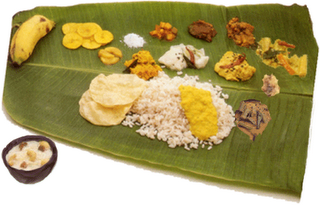Ugadi

Coming close on the heels of Holi, Ugadi marks the beginning of New Year. The festival is celebrated with great fervour in Maharashtra, Karnataka and Andhra Pradesh. While it is known as Ugadi in Andhra and Karnataka, it is celebrated as Gudipadava in Maharashtra. Keralites celebrate the New Year with Vishu and Tamilians call it Varshapirappu.
Vishu kani
Ugadi derives its name from Yuga Aadi (Yuga and Aadi means beginning of new age) and marks the beginning of Vasanth Ruthu (spring). It also symbolises new life. For the festival, preparations begin a week ahead. Houses are washed thoroughly and people purchase new clothes. Entrance of houses are decorated with fresh mango leaves. Poojas are conducted.
Ugadi is also considered to be the most auspicious time to start new ventures. People consume Bevu (neem) and Bella (jaggery). The inner significance of this is to indicate that life is indeed a mixture of good and bad, joy and sorrow.
Preparations for the festival begin a week ahead. Houses are given a complete wash. Raw mangoes spread its aroma in the air during the season and fully blossomed neem trees makes the air healthy. Special dishes are prepared for the occasion. Jaggery with sugarcane adds a renewed flavour to Ugadi. Ugadi Pachchadi is synonymous with the festival. It is made of new jaggery, raw mango pieces and neem flowers and new tamarind.
 In Andhra Pradesh, eatables such as pulihora, bobbatlu and preparations made with raw mango are a must on the occasion. In Karnataka too, puliogre and holige are the specialties. Maharashtrians make puran poli or sweet rotis. With raw mango available in abundance only during the two months of April/May, people in Andhra Pradesh make good use of mangoes to last until the next season. They pickle the mangoes with salt, powdered mustard and powdered
In Andhra Pradesh, eatables such as pulihora, bobbatlu and preparations made with raw mango are a must on the occasion. In Karnataka too, puliogre and holige are the specialties. Maharashtrians make puran poli or sweet rotis. With raw mango available in abundance only during the two months of April/May, people in Andhra Pradesh make good use of mangoes to last until the next season. They pickle the mangoes with salt, powdered mustard and powdered dry red chilli and a lot of oil to float over the mangoes. This preparation is called avakai and lasts for a whole year.
dry red chilli and a lot of oil to float over the mangoes. This preparation is called avakai and lasts for a whole year.In Tamil Nadu, varshapirappu is celebrated with pooja and elaborate cooking. Some of the delicacies include payasam, mango pacchadi, curd Pacchadi and vadai.
In Kerala, Vishu is celebrated in a traditional manner. Keralites follow the custom of viewing Vishukani (the lucky sight) at 3 a.m. Vishukani is later taken and distributed among the poor.
 People wear new clothes (kodi vastram) and the elders of the family distribute tokens of money to the children, servants and tenants. These tokens are called Vishukaineetam and are usually in the form of coins. People carry on this custom believing that in this way, children will be blessed with prosperity in future.
People wear new clothes (kodi vastram) and the elders of the family distribute tokens of money to the children, servants and tenants. These tokens are called Vishukaineetam and are usually in the form of coins. People carry on this custom believing that in this way, children will be blessed with prosperity in future.The families then celebrate the day with gay abandon by bursting crackers after seeing the Vishukani. The feast or the sadya is prepared and relished by the family. Dishes are prepared from vegetables and fruits like jackfruits, mangoes, pumpkins, a variety of gourds, and coconuts apart from varieties of payasam.
Devotees throng temples like Guruvayur, Sabarimala and Padmanabha Shetram. Special pujas are held in these temples where people go to worship and pray for a prosperous New Year. They also view the Vishukani prepared in the temples.
For Vishukani, konna pua (yellow laburnum flower), fruits like jackfruit and mangoes, vegetables like gourds and snake gourds, ornaments made of gold, bell metal mirror with a white pleated cloth tied to its handle (supposedly used by Goddess Parvati), the traditional bronze vessal Uruli filled with rice, items used for daily worship (asthamangalam), clothes with pure gold zari, a split coconut, some coins in a silver cup, some water in od, a traditional vessel and a grantha, which is a palm leaf manuscript or the
 Bhagwat Gita are arranged.Vishukani is prepared by the oldest member of the family the night before Vishu and the family members supposed to view it only after midnight. The kani is place in front of an image of Lord Vishnu and diyas are lit.
Bhagwat Gita are arranged.Vishukani is prepared by the oldest member of the family the night before Vishu and the family members supposed to view it only after midnight. The kani is place in front of an image of Lord Vishnu and diyas are lit.Early morning, the oldest member of the family, after having viewed the kani and finished her puja, blindfolds each member of the family and sets them in front of the display. The idea being that all the members of the family view the Vishukani the first thing in the morning.
They first look at the image, then the yellow light of the diyas and the kani in the yellow vessels. So the dominant colour of the festival is yellow.
The Malayalees believe that viewing the kani ensures good fortune through out the coming year.
Tags:





0 comments :